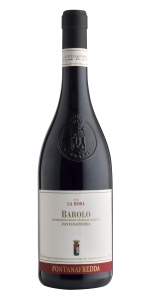Wine from Fontanafredda
Born in 1858 from the love story between the King of Italy, Vittorio Emanuele II, and Rosa Vercellana. We have always been a community, united by respect for the land, and today we have 120 hectares of ORGANIC crops that frame Italy’s first Storytelling Village.
We have 120 hectares of land, divided between the municipalities of Serralunga d’Alba, Barolo, Diano d’Alba, Dogliani, Farigliano, Alba and Rodello, at altitudes ranging between 250 and 420 metres above sea level, cultivated with Nebbiolo, Barbera, Dolcetto, Nascetta, Pinot Noir, Chardonnay and Moscato, which represent the starting point for the remarkable quality of our wines.
The climate is typically continental, but with considerable variability in terms of rainfall and temperature, resulting in an extraordinary diversity of harvests.
The richness of our soils is due to their mainly calcareous composition with different textures even just a few metres apart, ranging from looser soils, with as much as 50% sand, such as those at the farthest end of Serralunga d’Alba and Barolo, to more loamy and clayey soils, like those in the highest area of Serralunga.
Our vines are old, having been planted between 1940 and 1999, and this allows us to have significant root depths that reward the qualitative diversity of each individual M.G.A.. When replacing vines or replanting our vineyards we use our own massal selections in order to maintain the same genetic material that has always distinguished Fontanafredda. And we experiment on small plots with new planting layouts or grafting systems that favour clean agriculture.
We are among the last producers to have maintained extensive woods in the Bassa Langa region, with a woodland area of 12 hectares. This helps us to increase the plant and animal biodiversity that facilitates our ORGANIC farming, launched in 2015 and certified in 2018. No herbicides, no pesticides, no synthetic fertilisers.
Practising organic farming stimulates the symbiotic relationship between vineyards and woods, with their respective wild flora and fauna. By keeping the pedological characteristics of our soils intact, we increase the development of the micro-organisms that determine the amount of organic matter in our soils for the enrichment of biodiversity.
We see organic farming not merely as a form of agriculture but as a way of life, which involves identifying with the plant as a living being and eliminating all unnecessary chemicals.
Reviews:
On the savory side, this red opens with freshly mowed grass, hay and eucalyptus aromas before revealing cherry, strawberry, rose and mineral flavors. Fleshy, with a matrix of dense tannins flexing their muscles on the finish. Shows excellent potential. Best from 2023 through 2042.
-Wine Spectator 96 Points
Floral and red fruit nose. Supple attack, very polished and concentrated, with fine-grained tannins and ample acidity. This has a linear drive, precision. and a very long finish. The rewards will be substantial for the patient consumer.
-Decanter 97 Points
- back
Selected Options
Wineries
Categories
Pricing
Countries
Regions
Grape Types
Wineries
Organic/Free Shipping
All older vintage wines have been purchased from a single collectors cellar. Pictures can be requested before shipment.
Cabrieres Chateauneuf du Pape Rouge L'Esprit is made from 50% Grenache, 15% Syrah, 15% Mourvèdre, 10% Cinsault and 10% remaining: Muscardin, Counoise, Picpoul, Terret noir, Vaccarèse, Clairette, Bourboulenc, Roussanne, Picardan.
The vineyard is situated on the high tablelands, which are characteristic of the northern area of Châteauneuf-du-Pape. The terrain consists mainly of alpine diluvium and chalky Miocenian soil, with large flint pebbles covering the surface. These pebbles conserve the heat of the day during the night, thus avoiding too much evaporation.
85-year-old vines. Aged 12 months in French oak. Intense ruby color, with a dominant nose of black fruits (blackcurrant and blackberry) evolving into smoke and grilled notes. Robust tannins on the palate with a long finish.
Pair with choice red meat, prime rib and game, or try with strong cheeses and chocolate dessert.





